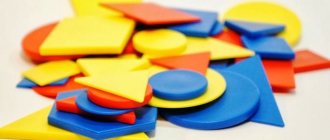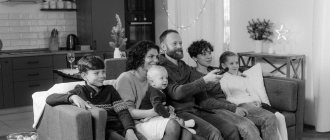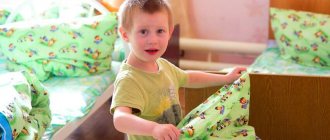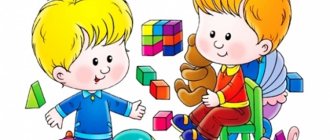Development of preschooler thinking
To find out how a child perceives the world around him, you need to know how a child, at a certain stage of life, comprehends the information received and systematizes it.
Understanding the age-related patterns of development of thought processes will make communication between a preschooler and an adult more enjoyable and productive.
As in any area of personality development, a child’s thinking goes through several stages and undergoes a number of changes. Parents need to know about the types of thinking that correspond to age characteristics.
Well-chosen games and joint activities have a positive impact on the formation of a child’s thinking and intellectual abilities.
Questions as a stimulus for thought
The questions that require children to think can be different, but they should all be aimed at activating their existing knowledge.
For example, what does a plant grow from?
- What kind of transport is called water transport?
- Which one is ground-based?
- Which one is airborne?
- Why doesn't a ball sink in water, but a round stone does?
- Will a snow woman become warm if she is dressed in a fur coat?
- What do birds that fly to warmer regions for the winter eat?
- Why is the balloon big but light?
- Why do puddles quickly disappear after rain in summer?
- Why does snow begin to melt in spring?
- Do trees grow in winter?
- Why, when a bouquet is placed in a vase, is water poured into it?
- Why does a duck have webbing between its toes, but a chicken does not?
Types of thinking
Visual - effective
This type of thinking corresponds to the early period of a child’s life (from 1.5 to 2 years). This age stage is characterized by exploring the world around us with the help of our hands. The child disassembles, studies, and sometimes breaks toys in the process of exploration. This is how ideas about the world around are formed.
If the child’s active actions are aimed at studying the objects around him, we can talk about a visually effective way of thinking.
The task of adults at this stage is not to interfere with the baby’s desire to explore, to give him the opportunity to independently study the objects around him.
We must not forget that in the process of studying, a child is capable of breaking, damaging and even injuring himself. Parents need to encourage the desire to learn new things, but safety precautions must be taken.
Visually – figuratively
The next stage begins at 3-4 years and continues until 7 years. This does not mean that the previous one disappears completely. In addition to the existing skills of exploring the surrounding reality, the preschooler thinks using images. During this age period, an active ability to draw is manifested. All available materials are used: from pebbles on the street to mother’s lipsticks on new wallpaper.
When drawing an object, the young researcher imagines the image, its essential features that remain in memory, and tries to convey its characteristic features. At this stage, it is important to translate into reality the images that appear in his mind.
Creative
Determines the ability to be creative – to create creative, non-standard solutions. A preschooler is not able to develop his creative abilities on his own, so the emergence of creativity in him largely depends on the wishes of his parents.
Unlike previous types, the creative type does not depend on the age characteristics and intellectual abilities of the child.
An important condition for the emergence of creativity are such forms of mental activity as fantasy and imagination, which are characteristic of any child. It is necessary to create an environment in which the little man will feel comfortable developing his creative impulses. The types of creativity are varied: visual, musical, arts and crafts, choreographic. literary.
Adults must remember that there are no children incapable of creativity. Even those children who lag behind their peers in development are able to find unusual, creative solutions to problems, provided that this is facilitated by classes with parents and teachers.
Spatial
This type is the basis for further educational and, subsequently, work activity. Developing spatial thinking is necessary for correct orientation in space, the appearance of images in the mind, and the ability to use them in solving problems.
The topic of migratory birds in spring at art lessons in preparatory groups
Young researchers need to be helped to correctly perceive the shapes, sizes of objects, their location relative to each other, and their movement in space.
Boolean
Just like spatial thinking, it is the foundation for further full intellectual development.
If the baby has not mastered logical thinking, he will experience learning difficulties. As a result, not only the health of the restless person will suffer, but also the keen interest in understanding the world around him will disappear.
Read more about the development of logical thinking in preschoolers.
Engineering
This type of thinking introduces children to science, increases interest in the work of scientists and researchers, broadens their horizons through experimental activities, design, and creates the prerequisites for technical creativity.
Modern children receive most information from television screens, and not through their hands. Experiences and experiments teach you to think outside the box and find answers to complex questions.
Child mental development - sequence
All these processes develop in a certain sequence - from practical reason to theoretical and, at the same time, in a complex, that is, those that have already developed are the basis for the development of more complex ones.
In mental education, it is necessary to provide for a certain chain of processes.
The outstanding researcher of child development problems A.V. Zaporozhets wrote that the mental development of a child is like a building: floor by floor. If any floor is lowered, the building will be shaky.
The same gaps occur in mental development, which manifests itself in its number of levels (knows, but does not understand), incapacity, and the like.
An important component of readiness to learn is cognitive activity.
Children in whom this activity develops in a timely and normal manner often annoy adults with questions like “What is this?”, “Why?” and etc.
This unique curiosity of children and its satisfaction by adults stimulate the child’s mental development, contribute to the formation of meaningful knowledge, that is, knowledge that children are able to independently use in situations that are new to them, and solve new everyday and educational problems.
It is known that not all children who come to school have developed those mental properties that provide them with further successful acquisition of knowledge and skills. These children experience great difficulties both in the process of acquiring knowledge and during its application.
Lack of formation of mental activity leads to formal assimilation of knowledge, which is characterized by superficiality and insufficient flexibility. Such knowledge is fragile, it is quickly forgotten.
So, in the multifaceted process of preparing children for school, a special place is occupied by the development of their mental activity and cognitive activity. If a child can read, this does not mean that he is already prepared for school.
A more significant indicator of this is understanding what you read or listen to: the ability to establish cause-and-effect relationships in the described phenomena, answer questions about what you read, and reason.
Formation of thinking of preschoolers
The development of thinking in a preschooler is determined by the ability to use universal mental operations inherent in thinking: attention, analysis, synthesis, comparison, classification, generalization.
Comparison
The baby learns to compare the essential and non-essential features of an object. It is necessary that he understands the importance of the process.
Analysis
This method allows you to break the object under study into parts and isolate its constituent components. For example, a child can easily name parts of a house: roof, chimney, window, door, etc.
Synthesis
The opposite of analysis is a mental operation, that is, in the process of synthesis, the preschooler combines individual elements into a whole. An example would be the skill of coherent reading.
Generalization
Typical for a preschooler aged 6 years. Appears as vocabulary accumulates and generalized concepts are used in speech.
Drawing lesson on the theme “Beautiful Bird” in middle groups
Classification
A mental operation that allows you to find similar and distinctive features of certain objects, concepts and phenomena.
Thought processes in children
It is the ability to perform mental operations that provides children with the conscious assimilation of knowledge and, at the same time, the further mental development of the child.
The mental development of a child can be traced in three planes:
- what the child knows, his worldview, whether he has a picture of the world at the end of preschool childhood;
- at what level of development are the child’s mental abilities and cognitive processes: perception, memory, speech, thinking, imagination, attention; what his interests are directed towards; what he has aptitudes and abilities for;
- to what extent the child has mastered certain academic skills - reading, counting, writing, organization, etc.
It is clear that in the overall picture of mental development these indicators are interrelated.
All children 5-6 years old have certain common signs of mental development, and at the same time, each child has distinct individual differences for each of these indicators, which most depend on the conditions in which the child grows and develops.
Researchers believe that more than 80% of the knowledge that an adult has is acquired in preschool age.
So, preschool age is special regarding the mental development of a child and a person. It is in the era of preschool childhood that all cognitive processes rapidly develop: perception, memory, speech, thinking, fantasy, and basic abilities and interests begin to develop.
Knowledge is undoubtedly an important indicator of the mental development of a child or adult.
But we can talk about a high level of development only when the child acquires knowledge on his own, when the child’s activities, games, work or education are structured in such a way that conditions are created for the development of his own cognitive capabilities, abilities, cognitive processes - sensory (sensations and perceptions) ), memory, speech, imagination, thinking, attention.
Methods for developing thinking in preschool children
For a child to be successful in school, timely, systematic preparation is important. If the child attends a preschool institution, the educational program of the kindergarten includes work on the development of thinking.
However, parents are able to make communication with their child productive and interesting by using small developmental tasks.
"Find the odd one out." Find the odd one among the suggested words and explain the solution. (Training generalization)
- Kilogram, hour, second.
- Notebook, glass, spoon.
- Pan, backpack, bag.
"Look for a mate." (Training analysis, comparison)
Children's lotto is used with pairs of similar cards. One child (the leader) takes the card and, without opening it to the others, tells what he sees on it. Others look at their cards and find an object on the card that is similar in description. If the description matches the answer, a couple of cards are removed from the game and the game continues.
Memory and attention are important mental processes that affect the intellectual development of a fidget. Therefore, when developing thinking, it is necessary to use tasks to develop attention and memory.
alt: Example of developing lotto “Fruits”
“One sign for all” (we develop thinking, speech, passive and active vocabulary, attention)
You need to name as many objects as possible that have this characteristic (for example, high). To do this, you need to answer the clarifying question: “What is tall?” (mountain, tree, closet, building, etc.)
“What’s missing” (training your memory)
The lesson does not require any special preparation. Objects in front of the child are covered with an opaque cloth, and one or more toys are hidden. Then the fabric is removed. The preschooler's task is to determine what has disappeared.
Games and exercises for the development of imaginative and logical thinking
- “What does it look like?” Show your child a picture of a fancy blot. Let the child come up with as many original associations for it as possible.
- "The fourth is odd." Invite your child to look at 4 pictures, three of which can be combined according to some characteristic. The child must understand which picture is “extra” and explain why he thinks so.
- “Call it in one word.” This game consists of an adult offering the child a set of words or images that can be combined into a concept. The child’s task is to name objects in one word (for example, tit, nightingale, woodpecker, crow, hawk - birds; raspberries, gooseberries, strawberries, watermelons - berries).
- “Put it into groups.” An adult places pre-prepared objects or their images on the table and mixes them. The preschooler must sort them into groups according to some characteristic.
- “Fold the picture.” This didactic game is an analogy to puzzles. The child’s task is to put together a whole picture from several parts.
- "Sudoku". This puzzle, popular all over the world, in its simplified version (2x2, 3x3 or 4x4), is also suitable for preschoolers.
- “Who eats what?” Select pictures depicting animals and their favorite delicacies, mix them, and then ask the child to make pairs (feed the animals). By analogy, you can play games such as “Moms and Their Babies”, “Who Lives Where?”, “Signs of the Seasons” and so on.
- “Continue the row.” Draw long beads and start a sequence of bead colors (for example, red, yellow, blue, red again). The child must color the rest of the beads, following the pattern.
To make it interesting and fun for your baby, try to introduce your child to new games and exercises every time.
- "Opposites". In this game, the child needs to come up with a word with the opposite meaning. For example, you say the word “big”, and the child says “small” (“cheerful” - “sad”, “loud” - “quiet”, “fast” - “slow”, and so on).
- "Guess what it's about." This game will help develop not only thinking, but also attentiveness. Describe one of the objects in the room, and the child must guess what it is about. For example, a fragile, glass, beautiful vase.
For other useful games and exercises, watch the video:
Board games (checkers, chess, strategy games), mazes and puzzles are also suitable for developing the thinking of preschoolers. Such games allow kids to learn how to make decisions, think through moves, and assess possible risks. Role-playing games, communicating with peers, reading and discussing books are also great for developing creative thinking.
Developmental tasks for preschoolers on logical thinking
If at a younger preschool age the leader is visual figurative thinking, then older children on the threshold of schooling should rely on logic in their conclusions. It is also important to justify all your decisions verbally. Therefore, this type of thinking has another name - verbal.
Effective techniques that develop verbal logical thinking in older preschoolers include didactic games and exercises.
Association games
Verbal games for building an associative series are perceived with interest by preschoolers, as they are based on images. Children imagine what is behind the proposed concept and come up with words related to this concept.
1. Who will praise best? Children are asked to come up with as many characteristics as possible for one object. You can add a competitive nature to this game.
2. Identify the owner. Children are given one or two striking signs, on the basis of which they determine a holistic image.
- tail and ears
- pen
- spines
- sheet
- lid
3. Free associations. Instructions: “What image or sign do you remember when you hear this word?” Several people can take part in the game. The first names any word, the second names its association with it, the third names the quality or concept associated with the previous word. Sometimes you can clarify why exactly this association arose in a preschooler.
Logical reasoning exercises
1.Complete tasks using visual material. Children are offered pictures with images where they have to identify an extra object, pick up a missing one, or insert a missing figure into its place.
The preschooler not only finds a solution, but also explains his choice and verbalizes his reasoning.
2. Tricky lotto. Prepare two identical sets of pictures. Children play in pairs, each participant receives their own set.
One of the participants chooses one picture at his discretion and, without showing it, describes the image, highlighting the main features. The second participant guesses and then offers his description of another picture.
3. Guess it! Participation of four or more children is desirable. Preschoolers form two subgroups. One of them agrees on what object to wish for. Participants in the second subgroup, in order to guess the object, ask questions that can only be answered in monosyllables - “yes” or “no.”
The task is not only to guess, but also to be able to identify important signs. Having received the answer, the subgroups change roles.
Message on the topic: “Development of mental operations in preschoolers” consultation on the topic
“Development of mental operations in preschool children”
Thinking is the most generalized form of mental activity that establishes connections and relationships between the objects being studied. Thinking radically expands a person’s capabilities in his desire to understand everything around him, since it operates not only with primary and secondary images, but also with concepts.
In preschool children, thinking develops in two directions: forms of thinking and mental operations develop, such as analysis, synthesis, generalization, classification, comparison, abstraction, concretization, etc.
Mental operations are a tool for a person to understand the surrounding reality, therefore their formation is an important factor in the formation of a comprehensively developed personality.
The ability to think clearly, logically, and clearly express one’s thoughts is currently required by everyone. These qualities are needed by a doctor and a business manager, an engineer and a worker, a salesman and a lawyer, and many others. Logical thinking is formed by older preschool age. It is at this age that it is necessary to devote more time to working with children to develop their mental operations. That is why issues of the development of mental operations are fundamental in preparing preschoolers for school.
However, at present, for the most part, children entering school are not prepared in this regard; they have poorly formed mental operations necessary for the successful acquisition of knowledge at school. The thinking of such children is at a low level, and there are quite a few specific programs for the development of mental operations.
The solution to this problem is carried out by searching for new ways, methods and forms of organizing the process of raising children in preschool institutions. And here the game comes to the fore as the main activity of preschool children. It is with the help of game methods that one can increase the efficiency of the formation of mental operations in a preschooler.
Many domestic and foreign teachers and psychologists have devoted their attention to the problem of the formation of mental operations in preschool children and the role of didactic games in it. Among them we can note such as L.A. Wenger, L.S. Vygotsky, D.B. Elkonin, N.P. Anikeeva, N.N. Poddyakov, J. Piaget and many others.
Basic mental operations:
Analysis is the division of a complex subject into its constituent parts or characteristics.
Synthesis is a mental transition from parts to the whole.
Comparison - establishing similarities and differences between objects.
Generalization is the mental unification of objects and phenomena according to their common and essential characteristics.
Classification is the division of a set into groups according to some criterion.
Abstraction is the selection of essential properties and connections of an object and abstraction from other, non-essential ones.
Concretization is the selection of the desired attribute, property of an object or phenomenon among others similar to it or similar to it.
Development of basic mental operations in preschool children.
The basis of all mental operations is analysis and synthesis.
Analysis is the division of a complex subject into its constituent parts or characteristics. Synthesis is a mental transition from parts to the whole. (For example, in a plant we distinguish the stem, root, flowers, leaves. An apple is round, smooth, green, etc.).
Analysis and synthesis are mutually complementary processes. Analysis is carried out through synthesis, and synthesis through analysis.
In childhood, analysis and synthesis first arise during practical manipulations with objects.
Synthesis in preschoolers develops earlier than the ability to analyze. Both analysis and synthesis in children develop according to the mechanism of internalization, i.e. At first, preschoolers have practical analysis and synthesis, and by older ages, they move on to the plan of internal mental actions.
To develop analysis and synthesis, good tasks involve selecting one or more objects from a group based on any criterion, for example, “Find all the round ones.” Or according to several specified signs (“Find the red circles”). Design tasks are suitable for developing the processes of analysis and synthesis.
Comparison - establishing similarities and differences between objects.
When making comparisons, the child must be able to identify some features of an object and abstract from others. It is recommended to first teach the child to compare two objects, then groups of objects (example....). It is easier for a child to first find signs of differences between objects and then signs of their similarity. With age, the preschooler compares objects according to more numerous characteristics and expresses differences in words (first by color, then by color and shape, etc.). Next, the child notices even slight similarities between the external signs of objects (for example, a glass and an aquarium), and can compare objects, imagining them mentally.
Generalization is the presentation in verbal form of the results of the comparison process. The nature of generalizations changes with age in a preschooler. Children gradually move from operating with external features (“birds”) to revealing features that are objectively more significant for the subject (“migratory”, “wintering”). A higher level of generalization allows the child to master the classification operation.
Classification is the division of a set into groups according to some criterion, which is called the “basis of classification”. With preschoolers, you can classify by name (cups and plates, skittles and balls, etc.), by size (large and small), by color, by shape and by other characteristics. For example, who runs, who swims; what you can and cannot eat, etc. This is a classification based on a given basis. In another case, the classification is performed on a basis determined by the children independently. The teacher sets the number of groups, and the children look for appropriate reasons. For example, household appliances, sports equipment.
The development of the ability to classify objects is associated with the development of generalizing words, the expansion of ideas and knowledge about the environment and the ability to identify significant features in an object. Moreover, the closer the objects are to the personal experience of the preschooler, the more accurate the generalization he makes. The child, first of all, identifies groups of objects with which he actively interacts: toys, furniture, dishes, clothes. With age, differentiation of related classification groups occurs: wild and domestic animals, tea and tableware, wintering and migratory birds.
Junior and middle preschoolers often motivate the identification of classification groups by the coincidence of external signs (“The sofa and the chair are together because they are in the room”) or based on the use of the purpose of objects (“they eat them,” “they put them on themselves”). Older preschoolers not only know generalizing words, but also, based on them, correctly motivate the identification of classification groups.
Abstraction is the selection of essential properties and connections of an object and abstraction from other, non-essential ones. For example, by observing how people, cars, planes, and animals move, we can identify one common feature in these objects - movement.
In the process of abstraction in preschoolers, the difficulty of identifying the main, essential is clearly manifested in the retelling of the text. It has been noticed that a short retelling is much more difficult for children than a detailed retelling. To tell briefly means highlighting the main thing, separating it from the details, and this is precisely what children do not know how to do. If you ask children to tell a short story, to tell only the main thing, they often miss significant semantic points, and the meaning of their retelling suffers greatly from this. To shorten a story and highlight only the main thing in it is not one task for a student, but two, and he often cannot master them at the same time.
Concretization – isolating the particular from the general. For example, from the concept of a person - a woman and a man.
Specification of the concept of “table”: “desk”, “dining table”, “cutting table”, “work table”.
Thus, the formation of a qualitatively new way of thinking in a preschool child is associated with the development of mental operations. In preschool age, they develop intensively and begin to act as methods of mental activity.
Mental operations are a tool for a person to understand the surrounding reality, therefore, the development of mental operations is an important factor in the formation of a comprehensively developed personality.





